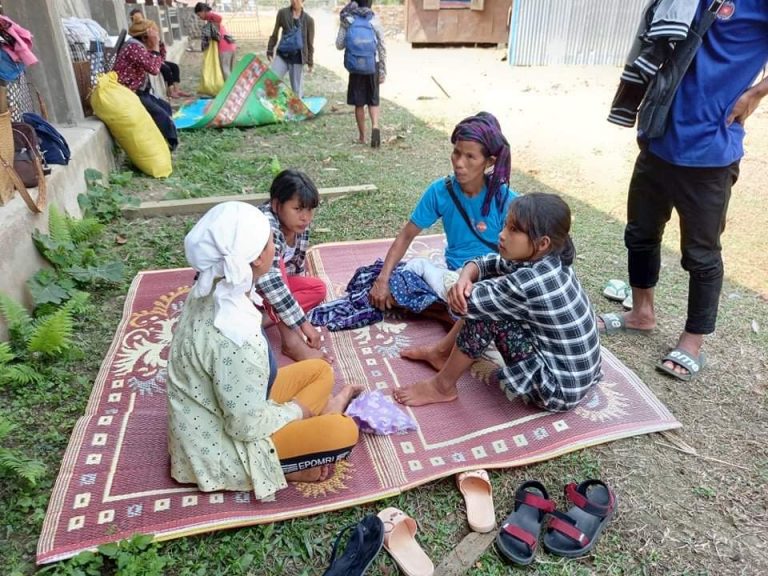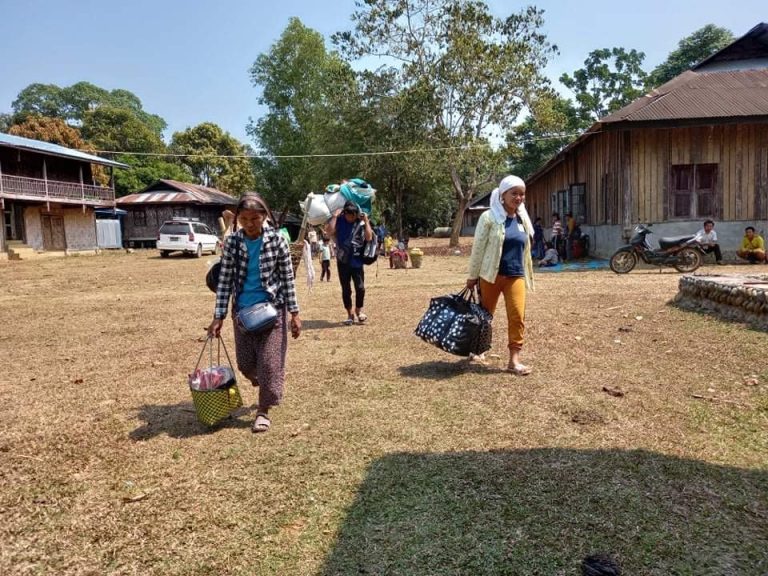Forty-two more civilians have fled their homes due to ongoing clashes between the Kachin Independence Army (KIA) and the Tatmadaw (Myanmar’s military) near the village of Gwi Htau in Injangyang Township in Kachin State. Gwi Htau is close to the controversial China-backed Myitsone Dam project, which has been suspended since 2011.
“A total of 42 people arrived today. Thirteen of them are Buddhists and they left by motorbike. Five more have also left Pa La Na camp for internally displaced persons and 27 remain at the camp,” Stephen Sut Awng, a priest at a Catholic church in Tang Hpare village in Myitkyina Township, told The Irrawaddy on Wednesday.
The Malikha River, a tributary for the Ayeyarwady, separates Injangyang and Myitkyina, the Kachin capital.
The 42 civilians are residents of Malizup village and internal migrants. They fled across the Malikha River on Wednesday, a day after the KIA and the Tatmadaw exchanged artillery fire.
Over 200 villagers from Gwi Htau and Tangbau Yang also fled across the Malikha River to Myitkyina on March 16, heading to the Pa La Na IDP camp in the Kachin State’s capital. They were stranded for hours in Tang Hpare village, as the commander of the Tatmadaw’s Northern Command would not allow them through a military checkpoint there.
Following mediation by the Kachin Peace-talk Creation Group (PCG), they were allowed to proceed to Pa La Na IDP camp at around 10 p.m.

The clash between the KIA and the Tatmadaw broke out on Monday evening, when the KIA attacked a Tatmadaw outpost in Gwi Htau Village, which is located close to the Myitsone Dam Project in Injangyang Township. Locals then reported hearing continuous artillery fire from 7 p.m. to midnight on Tuesday.
“There was an exchange of artillery fire on Tuesday. It was not a head-to-head fight,” said Lamai Gumja of the PCG.
There have been fewer major clashes between the KIA and the Tatmadaw since the two sides started negotiating a ceasefire in December 2018. And the PCG has also acted as a mediator between the two sides.
After the military’s Feb. 1 coup, the KIA asked the Northern Command via the PCG not to harm peaceful Kachin people protesting against the military regime. But two men died when the military opened fire with live rounds on anti-regime protesters in Myitkyina in March.
Three days after the fatal shootings the KIA attacked a Tatmadaw outpost in Hpakant. “Following clashes in 2011, the KIA has maintained a defensive position for the last ten years. I don’t know why the KIA is reversing that after all these years. But if this situation continues, the fighting could become intense. We are extremely concerned. Fatal shootings of protesters might also be a factor,” Lamai Gumja said.
When asked about the KIA’s attacks, the armed group’s information officer Colonel Naw Bu said he would not disclose details about KIA military operations to the media.

“What I can say is that the attacks have probably been arranged by frontline commanders as a response to Tatmadaw attacks,” said Col. Naw Bu.
Tensions between the two sides have also increased in the border town of Muse in northern Shan State since the Feb.1 coup. The KIA said that the fighting in Muse was started by the Tatmadaw.
On March 11 KIA leader General Gun Maw ordered the armed group’s brigades four, six and ten to attack the Tatmadaw, while avoiding residential areas and the Sino-Myanmar oil and gas pipelines.
The military regime has said nothing about the Tatmadaw’s tensions with the KIA. It has offered to continue peace talks with the four-member Northern Alliance, a military alliance which the KIA is a member of, in the hope of signing bilateral ceasefire agreements.
The Northern Alliance reportedly told the junta that peace talks could not be held in the current political climate.
You may also like these stories:
Myanmar Regime Announces Fresh Corruption Case Against Daw Aung San Suu Kyi











